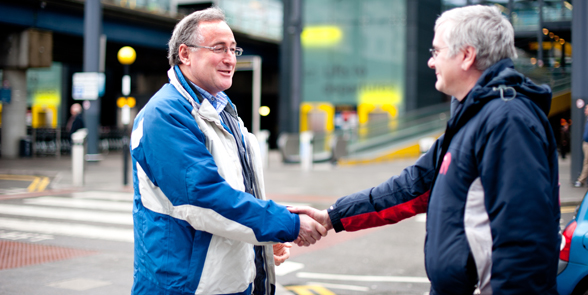The history of handshakes

Archaeological ruins and ancient texts reveal that handshaking was practised in ancient Greece as far back as the 5th century BC. At I Love meet and greet, we may not have been around to witness the invention of the handshake, but we have however participated in our fair share of hand shaking over the years.
Our airport valet parking service begins and ends with a handshake and therefore we believe our staff have mastered and perfected the most popular types of handshakes that are widely used across the world today.
So what is the main purpose of the handshake? During the medieval times, when most men were covered in armour, the handshake was a manner of greeting used to show friendship. If one male extended an open hand to another, this was understood to reflect an extension of friendship and the gesture would then be returned. However, the alternative would be a hand extended accompanied with a dagger or sword, which of course determined who was one’s friend or one’s foe.
Over the years, the handshake has proven to cause many controversies. From the British Olympic Association's head doctor advising athletes from the 2012 Olympics ‘not to shake their rivals hands in case they caught a bug’ to Wayne Bridge publically humiliating John Terry by rejecting a handshake pre-match. Body language plays a crucial role in day-to-day human interaction.
Many people are under the false impression that there is only one type of handshake that people use to greet one another. The Oxford Dictionary defines the word by saying it’s ‘an act of shaking a person’s hand with one’s own as a greeting.’ Even the definition of the word underestimates how much variety and personality goes into the hand action. At I Love meet and greet we asked all of our staff to tell us the most unusual handshakes they have been involved with and below are the top 3!
Described as the ‘Dead Fish’ in The Guardian’s ‘Top 10 Handshakes’, this limp, lifeless handshake is one that our staff sees regularly. The handshake got its name from the described feeling of shaking someone’s hand that has no bones in it. According to The Guardian, “Individuals with this type of clasp are generally not people-focused. Knowing this, you can tailor your presentation to de-emphasize the people aspect and focus more on the mechanical or thing-focused benefits.”
Next we have the ‘just fingers’ handshake, which pretty much just does what it says on the tin. Socialanxietydisorder.com describes this greeting as ‘even worse than the limp handshake, as this is the one in which you only shake the other person's fingers.”
And finally the one that takes us all by surprise, ‘The Backhander’. www.readwave.com says that “this occurs when you reach to shake a person’s hand, but they have something in their right hand. They don’t want to blow you off, so they throw their left hand out and you're suddenly thrust into that awkward situation where you think, what do I do now?”
Rather than expressing deference, a handshake between two people expresses willingness for equality and peace. We agree with Rob Leigh from The Mirror who said: “A handshake − whether it be weak, strong or all fingers and no fist − is better than no handshake at all, especially when the world is watching.”
By Sarah Anglim at 3 Apr 2014